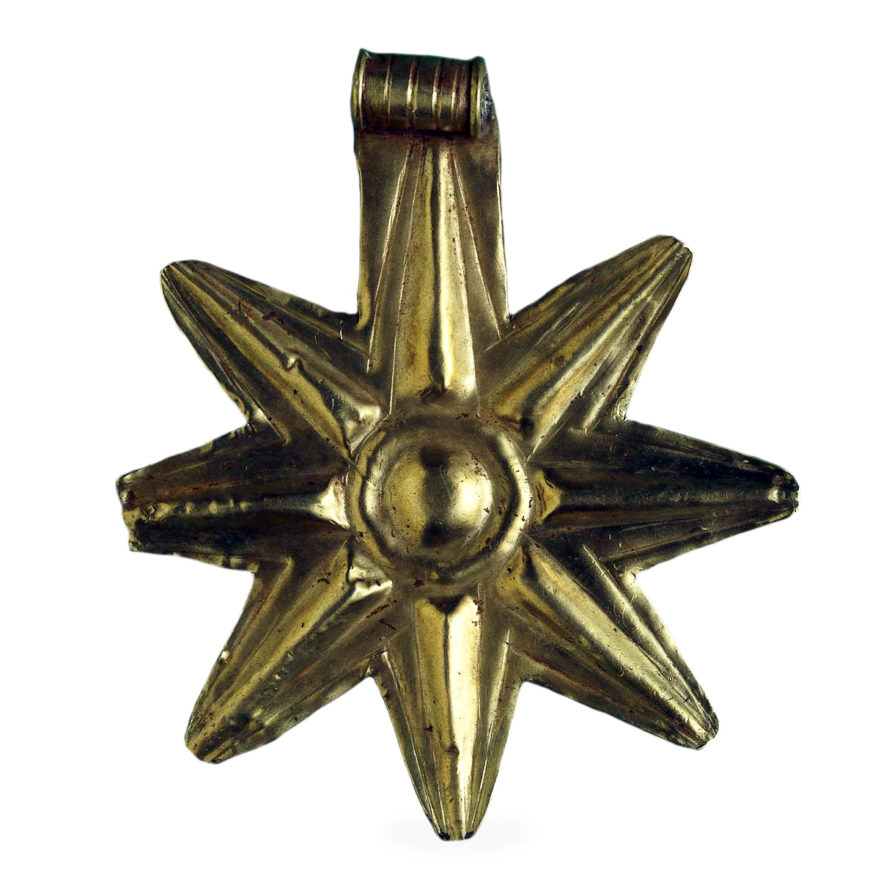
Pendant from the Tell el-cAjjul hoard, Canaanite, about 1750–1550 B.C.E., from Tell el-cAjjul, Israel (© The Trustees of the British Museum)
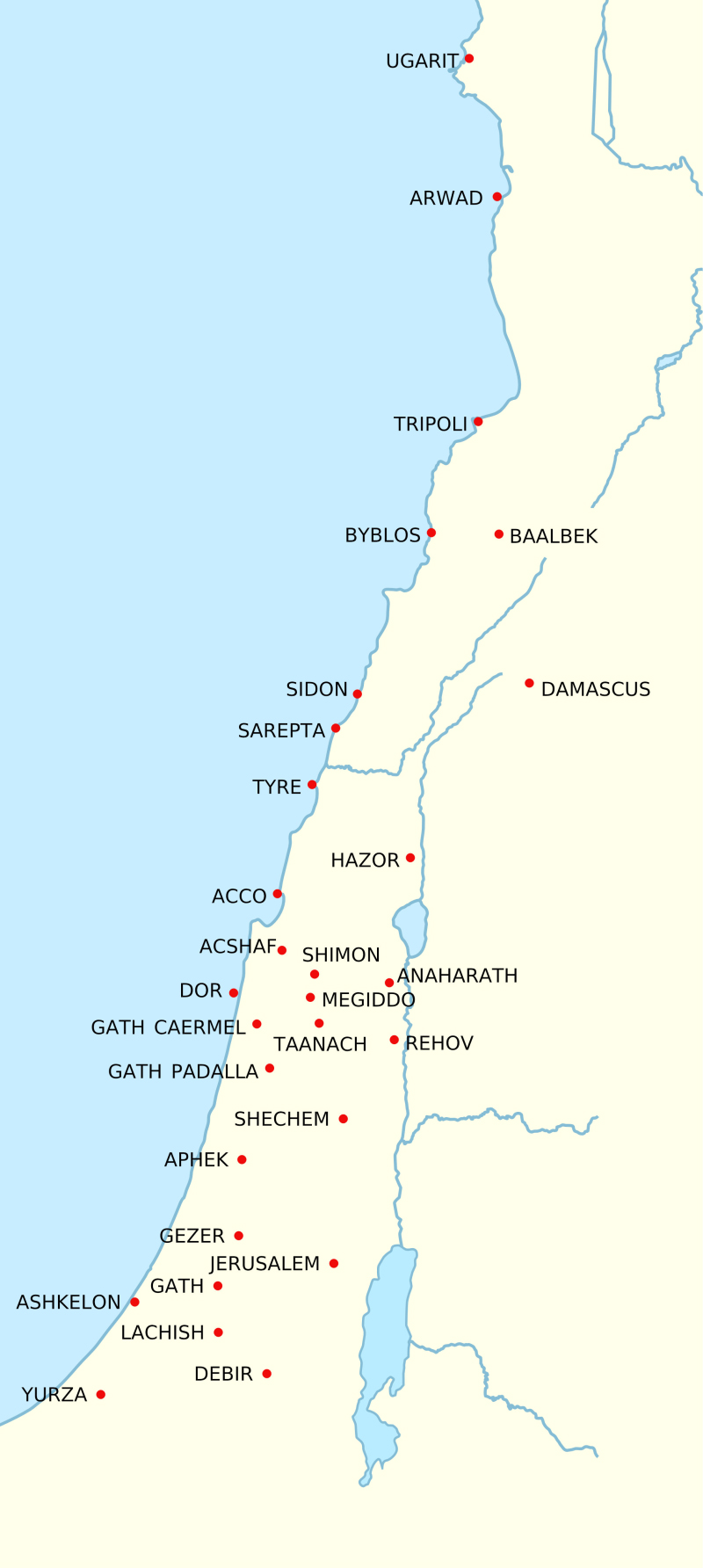
The major Canaanite city-states in the Bronze Age (map: IYY, CC BY-SA 4.0)
The Canaanites were the Indigenous people of the ancient Levant (modern Israel, Palestine, Transjordan, Lebanon and coastal Syria). They spoke a Semitic language related to Hebrew. During the Early Bronze Age, as trade with Egypt increased, strongly defended cities developed throughout the region which formed the centers of independent states. Egyptian campaigns were occasionally launched against some Canaanite cities but relations were normally maintained through trade.
Starting around 2000 B.C.E., Canaanites began to infiltrate the Egyptian Delta, and their donkey caravans can be seen on a number of Egyptian tomb paintings. By 1700 B.C.E. they had seized control of the Delta and established a local dynasty known as the Hyksos or “Shepherd Kings.” This period (1700–1480 B.C.E.) saw the development of a rich and imaginative artistic style, and it was at this time too that the Canaanites developed an alphabetic writing system that was passed on to the Phoenicians.
Around 1550 B.C.E. the Hyksos were driven from Egypt by the energetic kings of the Eighteenth Dynasty, and Tuthmosis III (1504–1450 B.C.E.) put the entire Canaanite region under direct imperial control. Throughout the period of the Egyptian Empire, disaffected and dispossessed Canaanites, known to the Egyptians as Habiru migrated to the hill country regions. This Habiru population formed the kernel of what was to become historical Israel, and it was referred to as such by the pharaoh Merneptah (reigned 1236–1223 B.C.E.) on a victory stele now in the Cairo Museum.
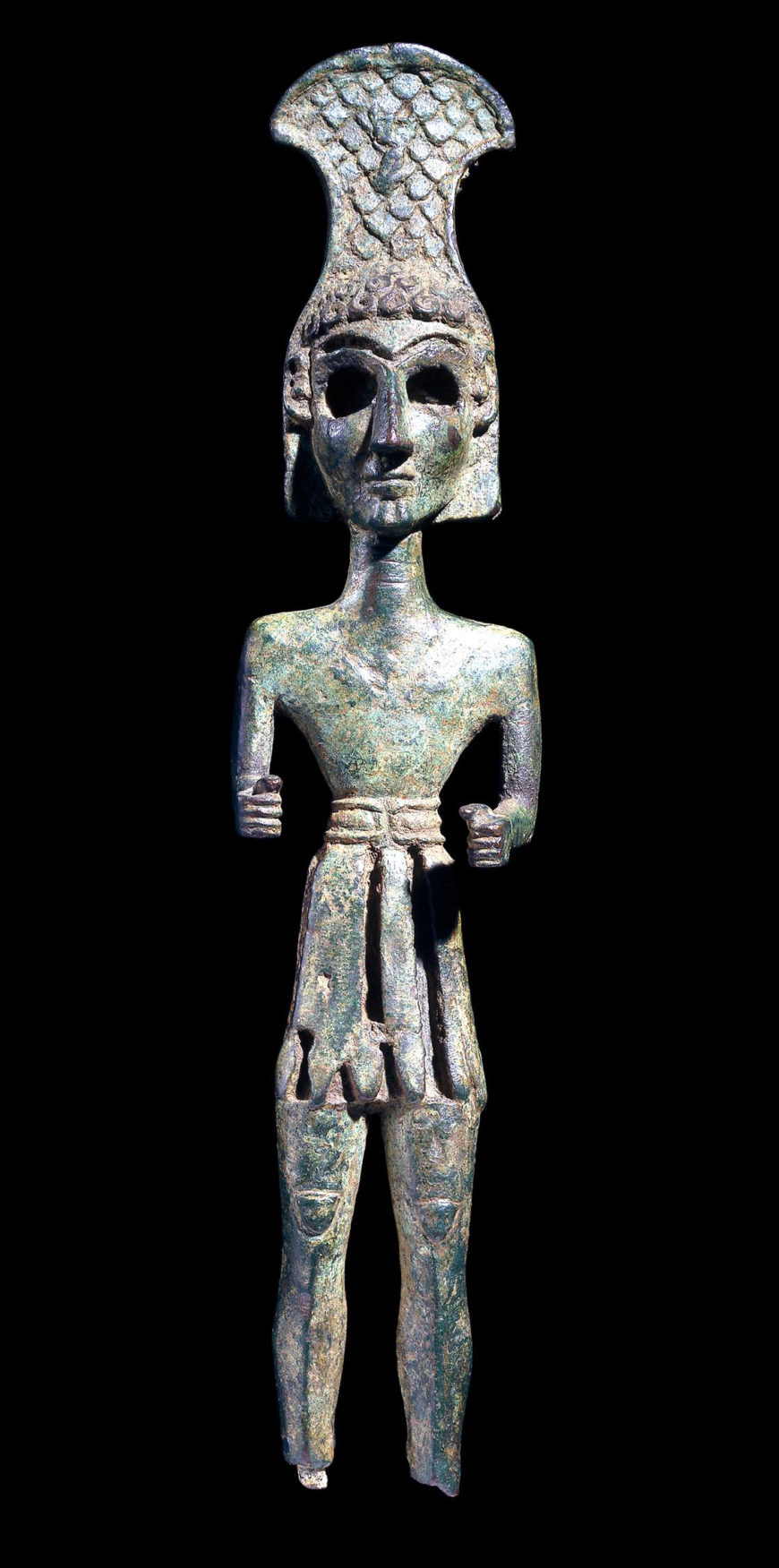
Bronze figurine of a warrior, probably a deity
Canaanite, c. 2000–1700 B.C.E., from the Levant, 27.3 cm high (© The Trustees of the British Museum)
A warrior god with feathered crown
This bronze figurine wears a broad belt fastened in front with a pair of ribbons, which suggests that he is a warrior. His headgear can be identified as a feathered crown. His hands are pierced and he probably originally carried weapons. He has been compared with Anatolian seals of the same period where a figure stands with a weapon in either hand before a seated god.
The figurine was probably cast in a double stone or clay mould. The channels along the back perhaps show that it was originally decorated with sheets of precious metal. Already in the third millennium B.C.E. several kinds of metal were used in the Levant for both casting and hammering. Lead, copper and bronze were generally used for solid-casting, while gold and silver were mainly hammered.
It is generally thought that human figurines such as this are images of deities. They may have served as cult idols (statues of deities to which prayers and offerings were made). It is perhaps more likely, though, that they were votive objects, given by worshippers with prayers to enlist the god’s favor or help.
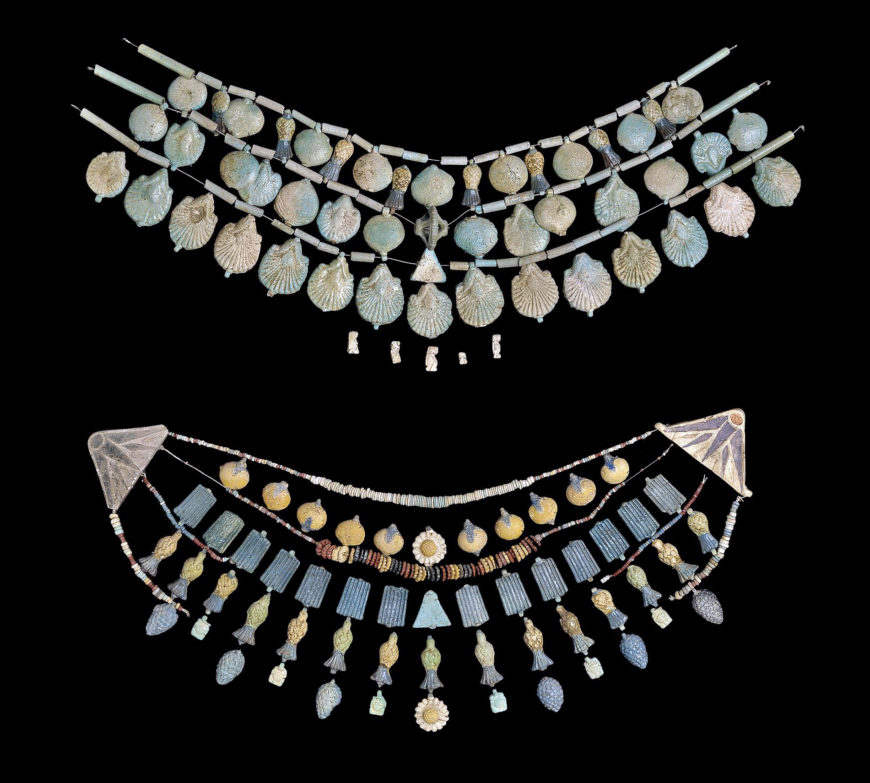
Necklaces of faience beads and pendants, Canaanite, about 1500–1200 B.C.E., from Lachish (modern Tell ed-Duweir), Israel, 13 cm long (© The Trustees of the British Museum)
Egyptian fashions in the southern Levant
These fine necklaces from the Fosse Temple at Lachish illustrates the strongly Egyptianizing style of Cannanite art of the Late Bronze Age. During this period the southern Levant was under Egyptian domination. Lachish is referred to in the Amarna letters—a group of clay tablets written in Babylonian cuneiform found at Tell el-Amarna in Egypt and preserving diplomatic correspondence to Egyptian pharaohs from vassal kings. The ruler of Lachish was Shipti-ba’al, a vassal king, subject to the firm control of Egypt, and enjoying the wealth and security that such political domination provided.
The so-called Fosse Temple was a small sanctuary first built around 1550 B.C.E. in the disused moat (fosse) that had formed part of the fortifications of Lachish in the early second millennium. A sudden destruction in about 1200 B.C.E. left remarkable contents in position in the building. These included many vessels containing the bones of animal offerings, and also rich finds of glass, faience and alabaster, imported pottery, ivories and jewelry in many materials, including gold and silver.
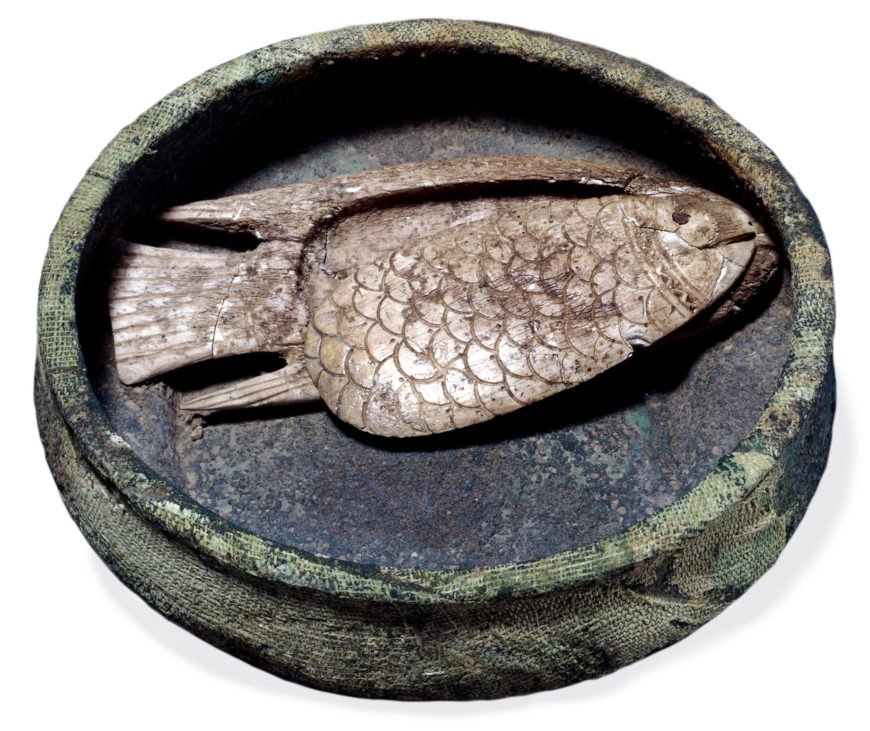
Ivory cosmetic box in the shape of a fish, Canaanite, 13th century B.C.E., from Tell es-Sa’idiyeh, Jordan, 11.5 cm long (© The Trustees of the British Museum)
Fish played a role in an unusual burial
This ivory fish-shaped cosmetic box was found inside a bronze bowl which had been strapped, using Egyptian linen, to the genitals of a body found in a grave at Tell es-Sa’idiyeh. Most unusually, the body had been placed face down in the grave, and over the back of the skull were found the skeletons of three fishes.
The site of Tell es-Sa’idiyeh controlled a shallow ford across the river Jordan. In the thirteenth century it was under Egyptian control. This was the final phase of Egypt’s domination of the Levant.
Most of the graves at Sa’idiyeh consist of simple, sub-rectangular pits, but the items found in them either show strong Egyptian influence or are purely Egyptian. This Egyptian influence helps explain some of the unusual burial practices. In several instances a bowl made of pottery, or more usually of bronze, had been placed either over the face or sometimes, as here, the genitals, of the individual buried. The majority of the bronze objects from the graves were found to be covered in textile remains, preserved by mineralization through the corrosion of the metal. The textile proved to be Egyptian linen. In some instances the evidence would suggest that the objects had been wrapped in cloth and deposited separately, but in others it is clear that they had been incorporated into a tight binding around the body. This is clearly related to the Egyptian practice of mummification, and indeed in a few cases a black resinous material covered the bones, presumably as a way of preserving the body.
© The Trustees of the British Museum
Additional resources:
J.N. Tubb, ‘Tell es-Sa’idiyeh: preliminary report on the first three seasons of renewed excavations’, Levant, 20 (1988), pp. 23–89
C.R. Cartwright, ‘Interim report on the archaeobotanical remains from the 1996 season of excavations of the Early Bronze Age complex at Tell es-Sa’idiyeh, Jordan’, Interim report on the ninth se, Palestine Exploration Quarterly 129 (1997), pp. 72–75
D. Collon, Ancient Near Eastern art (London, The British Museum Press, 1995)
C.R. Cartwright, ‘The archaeobotanical remains from the 1993 season of excavations of the Early Bronze Age complex at Tell es-Sa’idiyeh, Jordan’, Interim report on the seventh, Palestine Exploration Quarterly 126 (1994), pp. 52–67
J.N. Tubb, Canaanites (London, The British Museum Press, 1998)

